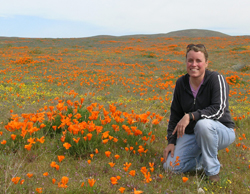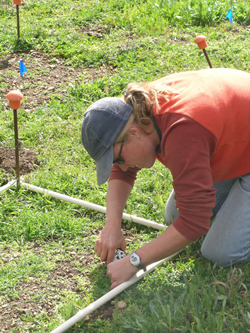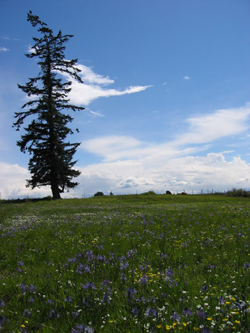|
Janneke (pronounced Yawn·uh·kuh) Hille Ris Lambers grew up thinking about plants. She was born to a rice geneticist father and a horticulturist mother. Because rice isn’t grown in her native country, The Netherlands, Janneke’s father worked at international institutes in tropical countries. Thus, many of her formative years were spent in the Philippines, a tropical island nation with spectacular rainforests and coral reefs. Janneke’s exposure to these diverse habitats awakened her interest in ecology, and her firsthand observations of their destruction through clear-cutting and dynamite fishing inspired her to pursue a career researching the environmental consequences of human activities.
Janneke’s first exposure to research came as an undergrad at the University of Virginia where she received her B.A. in environmental science. Taking advantage of the National Science Foundation’s Research Experience for Undergrads, she signed on to help a master’s student study southern range limits of a conifer in the Appalachians. Realizing she had discovered her niche in field ecology, Janneke went to Duke University to study under Jim Clark for her Ph.D. Working with Clark instilled in Janneke a drive to investigate applied questions in ecology, collect huge amounts of experimental data, and use sophisticated statistics to interpret those data.
|
The basic question of interest to Janneke is how plant species coexist. Specifically, what are the mechanisms that permit, and even promote, plant species diversity? This fundamental question in ecology underlies an important and timely applied question: what are the effects of human-induced environmental change on plant communities? Janneke has investigated these topics in plant communities across the country, including prairies in Minnesota, oak savannahs in California, and deciduous forests in North Carolina.
Janneke joined the UW Department of Biology in the fall of 2006 and is exploring field sites in the Pacific Northwest to complement ongoing research projects in California and North Carolina. Currently she has initiated the Pacific Northwest part of a global study led by investigators at Oregon State University.
|
In collaboration with Jonathan Bakker (UW College of Forest Resources) Janneke is establishing sites in several Western Washington grasslands to study the effects of resource limitation on plant diversity. The idea is that soil nutrients (e.g., nitrogen, phosphorus) limit the number of plants an area of land can support. So Janneke aims to find out what happens if nutrients that are typically limiting are added to the soil. For instance, does the species composition change? Are there more species or fewer? If there are fewer species, which species fall out of the community? Generally it is thought that limitation by multiple resources promotes species diversity because plant species can coexist by specializing on different soil resources. By staging experiments in which the soil is amended with different nutrients they can actually test this theory. In addition to answering basic ecological questions, these results will lend practical insight into the long-term effects of fertilizer addition to grassland habitats.
A second research project Janneke is planning goes back to the topic she investigated as an undergrad: species ranges. Janneke is developing a project to study the geographic ranges of several Pacific Northwest conifers and how they might shift given global climate change. There are decades of data for adult tree growth and survival, but little on seedling survival. Janneke plans to plant seedlings in experimental plots and measure growth and survival, as well as critical climatic variables such as snow pack. By integrating the seedling data with the existing data on how adult trees grow and survive in different climate regimes, she can determine the climates to which the different tree species are adapted. Collaborating with Jessica Lundquist (UW Civil & Environmental Engineering), Janneke will combine these data with regional climate models to explore how species ranges might shift based on forecasted changes in climate. Although climate is not the only variable dictating species ranges, it is a major one that many people believe will change significantly in the near future. And understanding how changes in climate may affect species ranges is essential for predicting the potential impact of climate change on one of The Evergreen State’s most prized possessions: the forests.
For more information on Janneke Hille Ris Lambers’ research, visit her website, which can be found through the faculty page on the UW Department of Biology’s website





